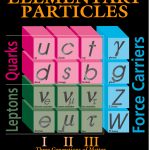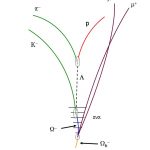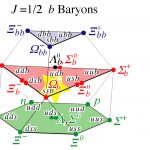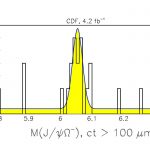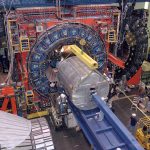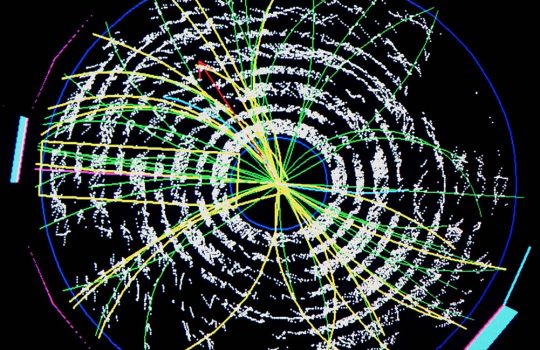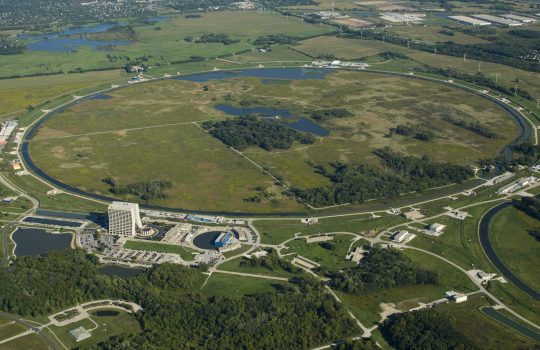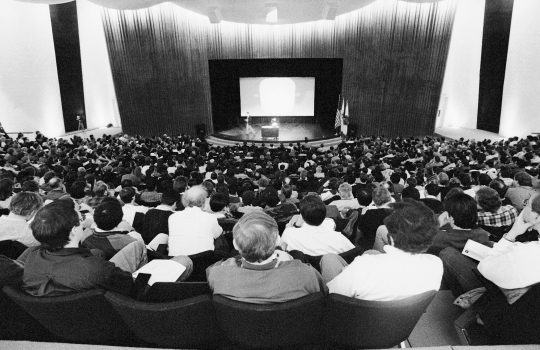At a recent physics seminar at the Department of Energy’s Fermi National Accelerator Laboratory, Fermilab physicist Pat Lukens of the CDF experiment announced the observation of a new particle, the Omega-sub-b (Ωb). The particle contains three quarks, two strange quarks and a bottom quark (s-s-b). It is an exotic relative of the much more common proton and has about six times the proton’s mass.
The observation of this “doubly strange” particle, predicted by the Standard Model, is significant because it strengthens physicists’ confidence in their understanding of how quarks form matter. In addition, it conflicts with a 2008 result announced by CDF’s sister experiment, DZero.
The Omega-sub-b is the latest entry in the “periodic table of baryons.” Baryons are particles formed of three quarks, the most common examples being the proton and neutron. The Tevatron particle accelerator at Fermilab is unique in its ability to produce baryons containing the b quark, and the large data samples now available after many years of successful running enable experimenters to find and study these rare particles. The observation opens a new window for scientists to investigate its properties and better understand this rare object.
Combing through almost half a quadrillion (1000 trillion) proton-antiproton collisions produced by Fermilab’s Tevatron particle collider, the CDF collaboration isolated 16 examples in which the particles emerging from a collision revealed the distinctive signature of the Omega-sub-b. Once produced, the Omega-sub-b travels a fraction of a millimeter before it decays into lighter particles. This decay, mediated by the weak force, occurs in about a trillionth of a second. In fact, CDF has performed the first ever measurement of the Omega-sub-b lifetime and obtained 1.13 +0.53-0.40 (stat.) ±0.02(syst.) trillionths of a second.
In August 2008, the DZero experiment announced its own observation of the Omega-sub-b based on a smaller sample of Tevatron data. Interestingly, the new CDF observation announced here is in direct conflict with the earlier DZero result. The CDF physicists measured the Omega-sub-b mass to be 6054.4 ±6.8(stat.) ±0.9(syst.) MeV/c2, compared to DZero’s 6165±10(stat.)±13(syst.) MeV/c2. These two experimental results are statistically inconsistent with each other leaving scientists from both experiments wondering whether they are measuring the same particle. Furthermore, the experiments observed different rates of production of this particle. Perhaps most interesting is that neither experiment sees a hint of evidence for the particle at the other’s measured value.
Although the latest result announced by CDF agrees with theoretical expectation for the Omega-sub-b both in the measured production rate and in the mass value, further investigation is needed to solve the puzzle of these conflicting results.
The Omega-sub-b discovery follows the observation of the Cascade-b-minus baryon (Ξb), first observed at the Tevatron in 2007, and two types of Sigma-sub-b baryons (Σb), discovered at the Tevatron in 2006.
The CDF collaboration submitted a paper that summarizes the details of its discovery to the journal Physical Review D. It is available online at: http://arxiv.org/abs/0905.3123
CDF is an international experiment of about 600 physicists from 62 institutions in 15 countries. It is supported by the U.S. Department of Energy, the National Science Foundation and a number of international funding agencies. Fermilab is a national laboratory funded by the Office of Science of the U.S. Department of Energy, operated under contract by Fermi Research Alliance, LLC.
- Six quarks–up, down, strange, charm, bottom and top–are the building blocks of matter. Protons and neutrons are made of up and down quarks, held together by the strong nuclear force. The CDF experiment now has observed the Omega-sub-b particle, which contains two strange quarks (s) and one bottom quark (b).
- Once produced, the Omega-sub-b (Ωb) particle travels about a third of a millimeter before it disintegrates into two intermediate particles called J/Psi (J/ψ) and Omega-minus (Ω-). The J/Psi then promptly decays into a pair of muons. The Omega-minus baryon, on the other hand, can travel several centimeters and occasionally be measured in the CDF silicon vertex detector. The particle decays into an unstable particle called a Lambda (Λ) baryon along with a long-lived kaon particle (K). The Lambda baryon, which has no electric charge, also can travel several centimeters prior to decaying into a proton (p) and a pion (π). Credit: CDF collaboration.
- Baryons are particles made of three quarks. The quark model predicts the combinations that exist with either spin J=1/2 (this graphic) or spin J=3/2. The graphic shows the various three-quark combinations with J=1/2 that are possible using the three lightest quarks–up, down and strange–and the bottom quark. The CDF collaboration observed the Omega-sub-b, highlighted in the graphic. There exist additional baryons involving the charm quark, which are not shown. The top quark, discovered at Fermilab in 1995, is too short-lived to become part of a baryon.
- The CDF collaboration has observed 16 Omega-sub-b candidates in the data collected through October 2008. The mass of the Omega-sub-b is measured to be 6054.4 ± 6.8 MeV/c2. The lifetime of the Omega-sub-b is measured to be 1.13 ± 0.53 picoseconds. Credit: CDF collaboration.
- The Fermilab accelerator complex accelerates protons and antiprotons close to the speed of light. Converting energy into mass, the Tevatron collider can produce particles that are heavier than the protons and antiprotons that are colliding. The Tevatron produces millions of proton-antiproton collisions per second, maximizing the chance for discovery. Two experiments, CDF and DZero, search for new types of particles emerging from the collisions.
- The CDF detector, about the size of a 3-story house, weighs about 6,000 tons. Its subsystems record the “debris” emerging from high-energy proton-antiproton collisions. The detector surrounds the collision point and records the path, energy and charge of the particles emerging from the collisions. This information can be used to find and determine the properties of the Omega-sub-b particle.
- Some of the 600 scientists of the CDF collaboration in front of Wilson Hall at Fermilab.

